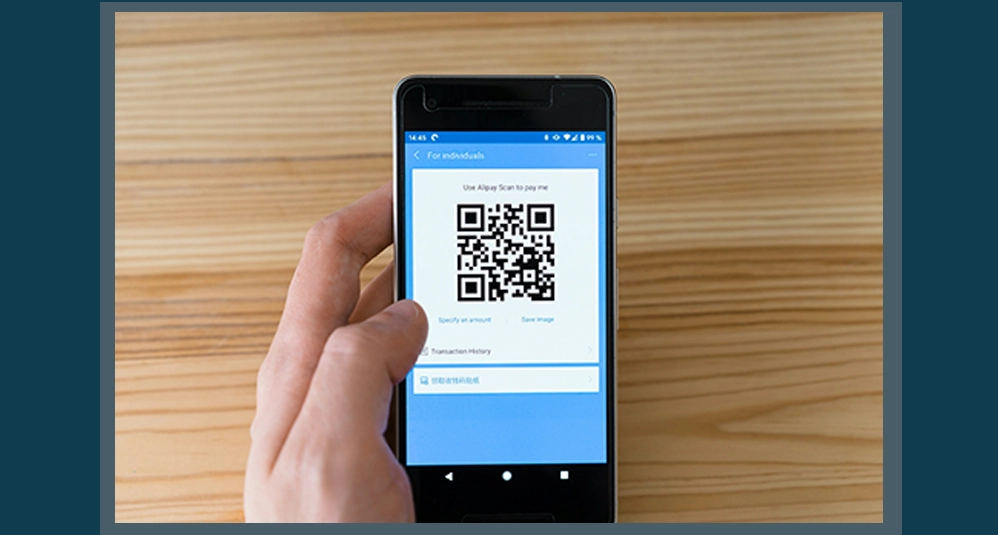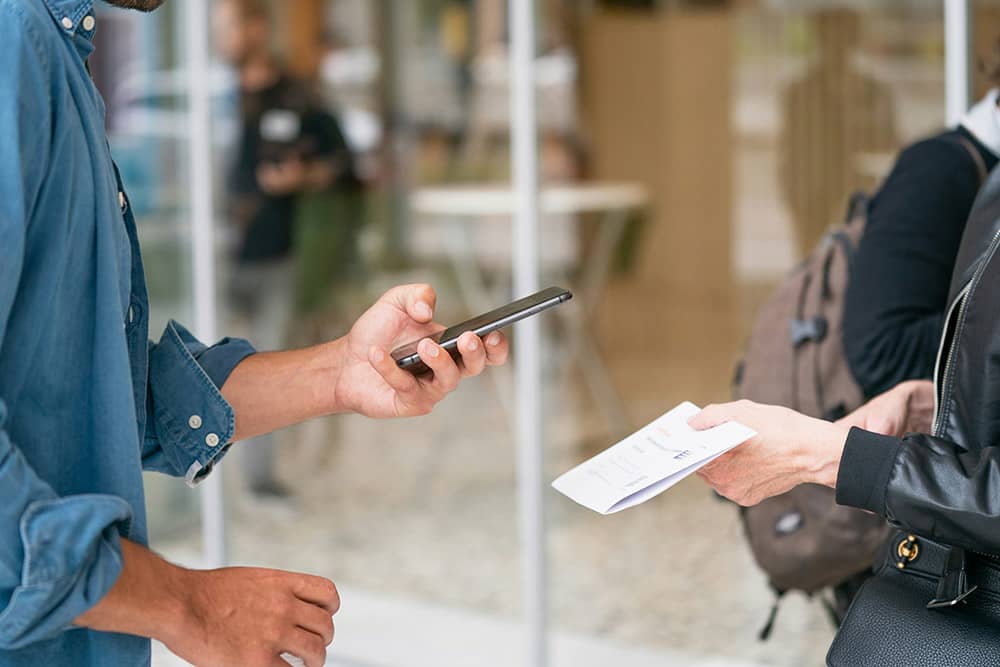Table of Contents
Technology in event management plays a crucial role in the modernisation and efficiency of processes. QR codes for events, in particular, have become an indispensable tool for organisers, allowing for a more agile and secure access management system at venues.
What is a QR code in events and how is it used?
A QR code (Quick Response Code) is more than just a two-dimensional barcode; it is a gateway to efficiency and interactivity in event organisation. These codes can be scanned using any mobile device with a camera, allowing instant access to the information stored within them. In the world of events, where agility and accuracy are key, QR codes have become essential tools for a number of reasons.
Streamlining Registration and Access
The first and most obvious use of QR codes for events is for registration and access. Instead of relying on paper lists or physical tickets, attendees can present a QR code directly from their mobile phone, which is scanned upon entry, simplifying the check-in process. This not only speeds up access, but also reduces paper usage, supporting sustainability initiatives.
Provide Relevant Information
In addition to the previous point, QR codes are used to provide relevant information to attendees instantly. By scanning a code, participants can access everything from the event programme to venue maps, speaker information, and much more. This means that all essential information is at their fingertips, up to date and easily accessible.
Encourage Interaction
Finally, QR codes for events can encourage interaction between attendees and with the event itself. For example, they can contain links to live polls, social media, or even games and challenges that take place during the event. This not only enhances the attendee experience, but also provides organisers with valuable data on attendee participation and preferences.
Networking through QR Codes at Events
One of the most innovative applications of QR codes for events is their ability to encourage networking. By scanning a QR code, participants can access networking platforms, share contact information digitally and connect to social media or event apps.
Using LinkedIn QR Codes for Networking
LinkedIn offers a QR code functionality that allows you to easily connect with other professionals at events. This feature can be used to avoid exchanging traditional business cards or to digitise the process, bringing your business card into the digital age by including your QR code. In addition, you can use your LinkedIn QR code as a lock screen on your phone during an event, or if you are giving a presentation, include your code in the presentation to allow your audience to easily connect with you from their seats. LinkedIn makes it easy to generate your own QR code for an event through its QR code generator, making it a valuable tool for connecting quickly and efficiently. By simply scanning the QR code, users can instantly access your LinkedIn profile, making it easy to exchange information, explore mutual interests and create valuable connections.
‘HEN India’ Tips on LinkedIn QR Codes
HEN India highlights the importance of LinkedIn’s QR codes for connecting seamlessly, reflecting how the professional network has evolved beyond traditional business cards and handshakes. LinkedIn’s QR codes facilitate the connection between offline interactions and online connections, making professional networking more nuanced during events.
Benefits of Using QR Codes for Events
The adoption of QR codes for events has revolutionised the way organisers plan and execute their events, offering a number of benefits that improve both operational efficiency and the attendee experience. These benefits not only make the process smoother for organisers, but also enrich attendee engagement, resulting in more successful and memorable events.
Efficiency in Registration and Access
Implementing QR codes for event registration and access transforms a traditionally slow and error-prone task into a fast and seamless process. By using QR codes, event organisers generally achieve the following improvements:
- Reduced Queues and Waiting Times: QR codes for events enable near-instant check-in, meaning attendees can be processed quickly, eliminating long queues and significantly reducing waiting times.
- Accelerated Processing: the ability to quickly scan a QR code for an event from a mobile device streamlines ticket verification, allowing organisers to process a larger number of attendees in less time.
- Minimisation of Errors: digitisation of the entry process reduces the possibility of human error associated with manual registration, ensuring that the attendant’s data is accurate and up to date.
Improving the Attendee Experience
QR codes for events also enrich the attendee experience by providing unprecedented access to relevant and personalised information in a convenient and timely manner:
- Instant Access to Information: attendees can scan QR codes for events scattered throughout the event to get information about sessions, speakers, exhibitors, and more — all from their mobile devices.
- Personalisation of the Experience: through QR codes, organisers can deliver personalised content based on the attendee’s preferences and behaviour, enhancing their overall experience at the event.
- Real-time updates: QR codes for events can be used to notify attendees of last-minute changes, ensuring they are always informed.
Implementing an Access Control System with QR Codes
The implementation of an event access control system with QR codes for events is a fundamental step towards the modernisation of events, allowing a more efficient and secure management of attendees. To carry out this implementation effectively, it is crucial to consider several fundamental aspects that will guarantee the success of the system.
Hardware Needed: QR Code Readers
- Reader selection: the first step is to select the right hardware to read QR codes. There are specialised readers that can handle a high volume of scans quickly, as well as mobile devices that can be equipped with specific applications for this function.
- Strategic Placement: readers should be placed at strategic points to facilitate entry flow and minimise bottlenecks. This includes main entrances, conference rooms, and exhibition areas.
- Integration with other systems: it is important that readers integrate seamlessly with the event registration software for a smooth check-in process and to update attendance in real time.
Event Management Software
- Unified Platform: the software should offer a comprehensive solution that not only handles access control, but also integrates with other areas of event management, such as attendee registration, session management, and data analysis.
- Ease of Use: an intuitive interface is key to ensuring that event staff can operate the system smoothly, from initial setup to live event management.
- Customisation and Scalability: the system must be flexible enough to adapt to the specific needs of each event, regardless of its size or complexity.
Information Security
- Data Protection: the security of attendee data is paramount. The system must comply with applicable data protection regulations and employ robust security measures to protect information from unauthorised access.
- Data Encryption: data stored and transmitted through the system must be encrypted to ensure its integrity and confidentiality.
- Security Audits and Updates: it is essential to perform regular security audits and to keep the system up to date with the latest protection measures against emerging threats.
Integration with Other Event Management Tools
- Compatibility with Other Solutions: to maximise efficiency, the access control system should integrate seamlessly with other event management tools, such as mobile apps for attendees, networking platforms, and content management solutions.
- APIs and Webhooks: the availability of APIs and webhooks facilitates integration with external systems and allows for greater customisation and automation of processes.
Eventscase, for example, offers a QR code access control solution that stands out for its ease of use, seamless integration with other event management tools and high security standards. By implementing this solution, event organisers can ensure a fast and secure entry process, enhancing the attendee experience and simplifying event management.
Conclusion
QR codes for events and access control systems are revolutionising event management, offering efficient, secure and personalised solutions. Eventscase is at the forefront of this transformation, providing event organisers with the tools they need to take full advantage of the benefits of technology.
About Eventscase
The Eventscase platform helps event organisers manage corporate events, conferences, and trade shows, whether large, small, in-person, hybrid, or virtual. No technical skill is required at all. Anyone can create beautiful event websites, registrations, badges, perform check-ins, event apps, 1:1 meetings and more. Everything under the brand and domain of your company can be implemented with an Eventscase whitelabelled platform.
If you would like to subscribe to our newsletter to get live updates on everything related to our platform – news, blogs, events, announcements and much more, please, register here.








